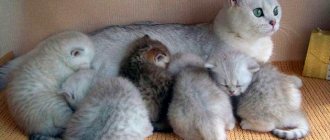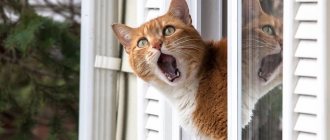(1 votes, rating: 1,00 out of 5)
5589564
08/04/2021 owner reviews
Most breeders cannot understand at the time of delivery of the pet whether the cat gave birth to all the kittens? This is necessary to avoid complications of subsequent pathological births. If the birth ends unsuccessfully, in this case the birth of all kittens, then this can lead to the death of the animal or a complete loss of reproductive function.
- How long does it take for a cat to give birth?
- How do I know when labor is over?
- Symptoms of unfinished business
- What we can do?
How long does it take for a cat to give birth?
The duration of work for representatives of the cat family depends on many individual factors. These include:
- physiological characteristics of a particular breed;
- How many times was lambing done?
- animal health;
- age of the cat;
- balance of hormones in the body;
- the conditions in which the animal is kept, its nutrition.
Most often, the normal birth of offspring in a cat lasts from 12 to 36 hours. Their duration takes into account the period of preparation, work and the birth of kittens. The kittens, in turn, come out into the world. The interval between their births can be from 30 minutes to an hour or more. There are situations where this may take several days.
© shutterstock
Cats have a physiological feature that, after the birth of a kitten, the contractions stop for a while, which allows the animal to recover and begin giving birth with renewed vigor.
When to see a doctor?
The doctor knows the whole process of labor better and will help immediately if the situation worsens. The doctor will understand that the cat has finished giving birth, or will determine whether the cat gave birth to all the kittens. Still, there is no need to bother the doctor over trifles, but then, in what cases should you run to the doctor?
If you notice that:
- The cat's body temperature exceeded 39 degrees.
- Greenish mucus is released from the vagina.
If you notice other signs of unborn babies, wait about a day. It is possible that the cat's body is resting and will begin laboring again when it is ready.
The doctor is the only one who can help your pet if the situation worsens.
How do I know when labor is over?
In the normal interval, the end of labor in cats is characterized by the following features:
- About an hour after the last kitten was born, her belly became soft.
- A cat can leave kittens.
- When all the kittens are born, the cat may become interested in food or water.
- Breathing becomes smooth and heartbeat becomes calm.
- The new mother begins to take care of her offspring, actively caring for the babies.
It is necessary to carefully and effortlessly feel the cat's abdominal area with both hands, making movements towards the ribs. This should be done at least half an hour after the birth of the last kitten.
A cat's calmness does not always mean that the overall process has already been completed. Most animals do not change their behavior during or after birth. If in doubt whether there are any unborn kittens left, consult a professional.
General information
So, let's start with the “truths”. Pregnancy in these animals lasts (on average) up to 64 days; cases are described when a cat walked for 70 days. The “average” pets give birth to four kittens per litter, but cases of six or even eight babies being born are not uncommon.
The only way to more or less accurately find out how many new pets you will have is to conduct an ultrasound examination.
The recommended period is at least 40 days of pregnancy. Keep in mind that even an ultrasound does not always provide complete information about the number of kittens: especially “nimble” cubs can overlap with others, as a result of which it can be quite difficult for the veterinarian to figure out the final number of babies.
But we are more interested in the process of childbirth itself. Contrary to popular belief, there is no need to run to the vet immediately after contractions appear.
- Firstly, pushing in general can be preparatory, and they often begin three days before the “true” birth.
- Secondly, the first contractions very often last for at least 12 hours , sometimes this period extends to a day. True, if your pet is primiparous or, on the contrary, old (in such cases the likelihood of complications is much higher), it won’t hurt to call the veterinarian at this time.
- Don’t forget that many cats “love” to give birth at night, and 24-hour veterinary clinics are not available everywhere. So it’s better to agree on your presence at the birth with a specialist in advance.
Symptoms of unfinished business
To determine whether there are still kittens in the cat's stomach, it is extremely important to prevent the development of postpartum complications. A baby left in the womb can cause the death of a cat. If this is still the case, decomposition will begin within a few days and the cat will be seriously poisoned. In another case, he may be mummified and the mother will not seriously harm him, but in this case his reproductive abilities will suffer. This is why it is so important to determine whether there are any kittens left in the cat’s stomach.
© shutterstock
If there is a suspicion that not all babies are born, you should carefully observe the animals. A number of characteristic signs indicate incomplete delivery:
- The cat continues to behave as if giving birth.
- The new mother does not show the necessary care for the kittens, does not feed them, does not lick herself.
- She is in no hurry to restore strength with water or food.
- When palpating the abdomen, a compaction is felt inside, it is hard or tense. There is no feeling that there is nothing there.
- 24 hours after birth, the cat’s temperature does not drop below 39 degrees.
- 48 hours after birth, blood is released from the birth canal, most often with an unpleasant odor.
All of the above signs indicate that not all kittens are born. In such a situation, an important decision will be to immediately seek qualified help. The clinic performs an internal examination of the animal and palpation of the abdomen, followed by an ultrasound, which will confirm or refute the hypothesis.
If the fetus is in the birth canal, what to do?
In this case, you can try to stimulate contractions so that the body itself pushes the kitten out. But if this doesn’t help, then you should pull out the stuck kitten yourself.
This process is very complex and requires enormous responsibility, since in your hands is the life of not only the kitten, but also the cat itself.
Wear sterile gloves and disinfect. If you see the kitten's head, check to see if the amniotic sac allows you to insert a finger into the fetus's mouth. If everything works out, turn the kitten's head in the right direction; contractions at this moment will help push him. Gently pull the kitten out. If the fetus is lying on its sacrum, pull the legs carefully.
If the fetus is dead, then you can no longer resort to being careful and pull the fetus by any part of the body, the main thing is to help the cat give birth to everyone. The natural process will help you give birth.
Helping a cat push out a kitten is dangerous. After all, this threatens the baby. The cat itself knows what it is doing, nature helps it bear it.
What we can do?
Since incomplete delivery can have tragic consequences, action must be taken immediately. Assuming that the kitten remains in the cat's womb for more than 24 hours after the end of labor, immediate action must be taken.
To expel the fetus remaining in the uterus, labor is stimulated with oxytocin at the rate of 0.3 ml. You can do this yourself, but seek help from a veterinarian. The doctor will calculate the exact dose of the medicine to ensure it is safe and effective. The administration of oxytocin often causes individual reactions; its administration is prohibited in the presence of transverse presentation and other pathologies.
The use of oxytocin has a positive effect on the termination of labor and promotes the removal of postpartum discharge in the uterus. Once the required result is obtained, a new diagnosis is made to determine whether kittens remain in the cat's uterus.
When providing obstetric care to a cat, the owner must be vigilant in order to know the basic characteristics of the cat's physiological structure. This will help to understand whether the process has completed or whether the kitten remains in the belly of the tailed animal. If there are any doubts about the end of labor, you should immediately seek qualified help from a special institution. Prompt action will help preserve the cat’s reproductive function, and in some cases, its life.
What to do if the cat cannot give birth to the “last baby”?
Let us emphasize once again that only a veterinarian can accurately identify the presence of “belated” kittens and only with an ultrasound (or x-ray, at worst). We would not recommend touching and kneading your pet’s belly on your own. So you are unlikely to be able to understand whether the cat gave birth to all the kittens or not, but it is entirely within your power to harm the animal.
So, there is a baby in the womb. For some reason, a cat cannot give birth on its own. What to do? If the animal is not very exhausted by childbirth and the muscles of the abdominal wall and the uterus itself are contracting normally, you can try to stimulate the “second round” of labor by administering oxytocin . In this case, there is a chance that the contractions that have started again will help bring the matter to an end.
But you need to remember that oxytocin is not the safest drug, and therefore when using it you need to take into account important nuances:
- If after administration of the first dose (no more than 5 IU) no signs of contractions are observed, further administration should be considered pointless and even dangerous.
- If the cat's body temperature does not exceed 37.5° Celsius, it is also not worth artificially inducing labor.
- Bradycardia, tachycardia, and other cardiac or respiratory disorders are also contraindications for oxytocin.
Thus, drug stimulation is not used too often, since for this the general condition of the cat must be close to ideal. But this, taking into account some “problems” at birth, does not happen often. In other words, we need some other option. And if the cat did not give birth to the last kitten, this is a cesarean section.
How is the pregnancy period going?
Also, the approaching moment of the birth of kittens is indicated by the fact that the animal begins to wash itself frequently, actively licking the area under the tail. He may even lick off all the hair in the genital area, which will make the birth of the kittens easier since they won't have to get tangled in their mother's fur.
From now on, you should have all the tools you might need to prepare your kittens. You should also have the veterinarian's phone number handy so that he can come immediately and look after the kittens until surgery.
What signs to look out for
Complications during calving are quite rare, but purebred kittens are more spoiled than their domestic sisters, so supervision and assistance are necessary during pregnancy and childbirth. If you look closely at the behavior of the animal, you can notice alarming phenomena, such as:
- Inconsistency in the number of kittens born and born.
- Effort appears.
- The cat does not get up and does not change position for a very long time.
- Lethargic, lethargic, neither drinking nor eating.
- Increased body temperature.
- A pregnant kitten cannot sleep.
- Tight, swollen belly.
- The bleeding did not stop after 24 hours.
- The discharge has an unpleasant odor and is green in color.
All of this indicates that the cat has an incomplete calving or the placenta has not leaked and requires immediate care.
Useful rules
There are several tips that, if followed, will not only help you carry and give birth to healthy babies for the first time, but will also keep you calm and on your nerves:
- A cat's pregnancy must be planned. And during the preparatory period, you need to consult a doctor, check for contraindications, possibly do a pelvic ultrasound and undergo some tests.
- A primiparous cat should maintain good physical activity , but without excessive stress. The objects she needs should be within reach so that the pet does not try to jump too high. There is no need to let a pregnant animal go outside unaccompanied.
- The future mother's nutrition should be complete and balanced . Deficiency of important elements should not be allowed: calcium, proteins, vitamins. Meat products and dairy products are required in the diet. Perhaps your doctor will recommend a vitamin complex. Do not neglect the recommendations if you want to get healthy offspring and keep your cat healthy.
- In the last days of pregnancy, purchase medications that may be needed during labor : Oxytocin to stimulate contractions, Gamavit to support the mother's body, Ringer's solution to prevent dehydration.
- If you are as inexperienced in feline birth as your pet, then you should think about professional help. If contractions occur, you can call the veterinarian at home, this will help prevent the occurrence of unforeseen complications.
- When assisting yourself during childbirth, carefully study the entire theoretical basis so that you are ready to provide assistance and do not panic at all. If health or life-threatening situations arise, seek medical help immediately.
Although labor is a natural process established by nature, the first time is always the most difficult, be it for a cat or for a person. After a couple of litters, your pet will become experienced enough to manage on her own. But it is better for a first-time mother not to be left without the support of a loving owner. And your task is to remain completely calm so that the inexperienced animal does not become even more nervous.
Have all the kittens been born?
Of course, when a single kitten is born, such questions do not arise. Of course, there are cases of single births, but they are rare. But let's say your cat has already given birth to three or four kittens. How do I know if they are still in the womb?
Only an ultrasound can answer this question, but there are signs that if you notice them, it is recommended to call your veterinarian or take your cat to the clinic:
- The birth appears complete, but your pet shows little interest in the newborn kittens, meows constantly, runs around the house, and shows other signs of extreme anxiety.
- Remember that in the normal course of labor there is a third stage of labor. This is not “officially” recognized by all veterinarians, because at this time the remains of the placenta and other “garbage” leave the animal. This stage should not be accompanied by cramps and pressure. If a cat that has already been born shakes and experiences strong contractions from time to time, there is clearly no problem. Either there are still kittens in her uterus, or there are signs of some postpartum abnormalities. In any case, it won't hurt you to contact your veterinarian right away.
- It happens that the kitten in the uterus (or several kittens) is already dead and for some reason the contractions are weak when they come out into the light. In such cases, a few days after birth, the cat's condition sharply deteriorates, and a greenish-brown discharge (ichorosis) with a disgusting, suffocating smell of rot appears from the external genitalia. It is easy to understand that even in such a situation an urgent visit to the veterinarian is necessary.
Normal course of pregnancy and childbirth
Behavior:
Change behavior. An active animal becomes peaceful, and a peaceful animal, on the contrary, becomes nervous. The cat begins to look for the place where it could have been born. He peed around the house, sometimes screaming and hissing. The place that is found is not always an outlet prepared by a person. He can hide behind an office, under a sofa, on the street or in a commercial building. This is very undesirable, because in this case it will be difficult to help her when necessary. Therefore, after noticing signs of a developing pregnancy, the owner must get used to the cat in a place that will become her nest for some time and after giving birth.
- Refusal to eat or drink.
- This occurs about a day before the scheduled delivery.
- You already have known signs that show the kitten is rising, but you need to understand how the pregnancy is progressing and what to expect after the addition.
An interesting situation in this type of animal occurs in 3 stages:
- Coverage and clear signs of fertilization may be visible after 3 weeks. Appetite impaired, drowsiness, tilt, toxicity, gestational edema, nipples.
- The animal begins to gain weight. Around 6 weeks they begin to be noticeable baby movements in the stomach.
- At the age of 7-8 weeks, there is noticeably increased anxiety, restlessness, and active kitten movement.
The spinning process can also be divided into 3 periods:
Maternal care
As a rule, there are no special recommendations for caring for healthy, newly born kittens with a mother present. The programs of maternal instincts in cats are laid down at the highest level, so it is better to take care of a pet who has devoted a lot of effort to the complex birth process.
Once a cat begins to feed its cubs with milk, it needs good nutrition, rich in proteins, vitamins and beneficial microelements. If there is an acute issue about the distribution of offspring, babies can be taught to eat independently from the age of three weeks.
- Opening of the birth canal and cervix (if the cat’s water breaks, this indicates the onset of labor).
- Birth of kittens (the birth interval for each of the litter's cubs is normally from 15 minutes to half an hour).
- Exit from the uterine cavity of the placenta.
How can a person help?
The mother's breathing is even, the heartbeat is rhythmic, the pulse is infrequent;
- The mother shows an active interest in the offspring, licks the kittens, feeds them, and brings them closer to her;
- Can change body position, get up from the nest, leave it for several minutes;
- After hard work, your pet feels increased appetite and thirst, and eats and drinks with pleasure.
- It is worth noting that all purebred cats have reduced instinct, so they will need your help. The main thing a person can do to help is:
- Prepare the calving area. It is best to use a medium sized open box.
- Cover the box with disposable diapers and change them when dirty.
- Have scissors ready in case the mother does not chew the baby's umbilical cord herself.
Stock up in advance on a drug that supports labor - calcium gluconate.
Signs of approaching labor
Rapid urination;
Changes in the nipple glands (swelling, redness).
- A cat carries babies for about 9 weeks, and exactly from 55 to 65 days. An animal can decide to eat three times a year, but this is a serious stress on its body.
- The owner easily finds that the birth and the cat is approaching.
- Physiological:
- Leisure and lengthening of the pelvic ligament - the animal has a slightly unsteady walk, has difficulty jumping on furniture, is inactive, the stomach is firmly sagging and appears to be moving on its hind legs.
- Decompression of the cross - lower part of the spine, dorsal part near the tail.
- Enlargement and swelling of the genital gap.
- Discover the mucus plug, a clear clump of mucus. Repeatedly born members are often licked before birth, so their emergence on the fork is unnoticeable. The original mother usually has a little mucus under her tail.
Enlarged nipple glands, the secretion of Kseason is a yellowish thick liquid (not always).
- A colorless and odorless liquid is removed from the genital opening.
- Decreased body temperature - the ears and tips of the paws become cold for about 24 hours before contractions begin.











